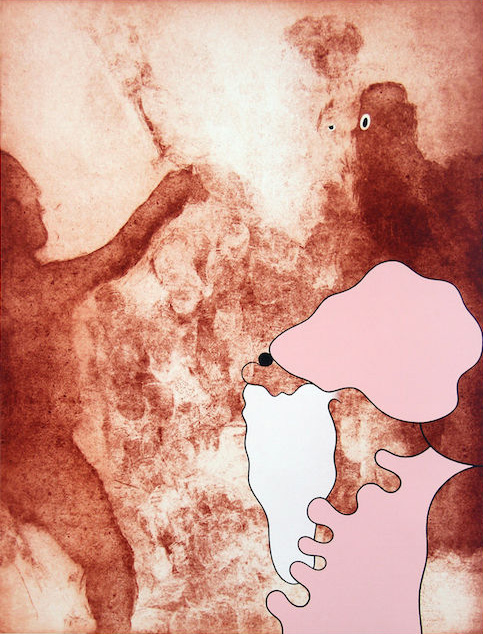The Problem
by Brent Harris
I have always worked my ideas across different media: painting, printmaking and drawing. Most often drawing comes first, which will then lead onto a print or a painting and this is often where things get mixed up. Sometimes a print will lead to a painting, but just as often a painting will be developed in a printmaking technique.
September 10, 2015
In Profile,
Printmaking
Since making The Fourteen Stations, a series of etchings and aquatints produced at Viridian Press with John Loane in 1989, Brent Harris’s involvement with printmaking has been long and varied, often overlapping and informing other areas of his practice.
In this new work, The Problem (2015), printed by Trent Walter of Negative Press, two techniques are combined: photopolymer gravure and screenprint.
The gravure plate forms the ground: a perplexing palimpsest of inky, layered imagery. Finger marks swarm and merge into strangely shifting profiles, a heavy figure lurches forward with one arm raised in an ambiguous gesture. These marks reference The Fall #7, a single monotype from a large series shown at Tolarno Galleries in 2012, in which the artist adopted an intuitive method referred to as the ‘dark field’ technique [ii]. In using this process Harris often embraced the absurd imagery that began to emerge as he wiped the blackened ground. [iii]
In contrast, the precise execution of the bearded foreground figure, achieved through three screenprinted layers, recalls the more graphic quality of earlier works such as the Swamp and Grotesquerie paintings from the late nineties and early noughties, where the compositions were resolved through drawing and reassembled on the canvas.
As is often the case in Harris’s work, the bearded figure in The Problem has travelled, in various incarnations, through a series of works. First emerging in a small panel painting on board in 2010, he resurfaces in a large painting The Dream (2015), and then again, reversed and enlarged, in the painting Peaks (2015). As in Peaks, where Harris describes this bearded figure as ‘some kind of witness’ [iv], his gaze is directed back into the work as if contemplating possible meanings buried in the marks of the ground. Etched and inked with red ochre, he might be looking at an ancient rock surface scarred by time: its ambiguous layers – where images, impressions, ideas emerge and overlap; can be felt, but also slip and recede – make sense in their resemblance to the experience and complexity of life itself.
Most recently, and corresponding with the development of The Problem, the figure appears again in a new painting, To the Garden (2015),which in its title and details refers to Gauguin’s painting Christ in the Garden of Olives (1889). This transference of information across time and media is a distinctive aspect of Harris’s practice. The artist’s imagery is continually evolving and suggesting, but resisting, set narratives or status; aptly dwelling between abstraction and ‘odd figuration’ [v].
Part of the lure of Harris’s work, evident in The Problem, is the artist’s willingness to remain open to the possibilities inherent in process. These are lived works, in which the artist’s singular visual language embraces complexity and reflects a deep knowledge and love of art.
[i] Brent Harris, artist statement, email correspondence, 2 September 2015.
[ii] A reductive technique where a plate is completely blacked out with printing ink and imagery emerges where the ink is wiped back. Usually only one good impression is printed.
[iii] Brent Harris, artist statement provided to Jane Devery for her article ‘Brent Harris: The Fall’, Imprint Vol 47 No 2, 2012. The artist stated: ‘as this series developed I found myself reflecting on the absurdities of the human condition’.
[iv] Brent Harris’s notes on the process leading to Peaks, 2015, email correspondence, 2 September 2015. Here Harris cites Colin McCahon’s early figurative paintings, such as Crucifixion according to St Mark (1947), as being full of witnesses.
[v] Brent Harris’s notes on Peaks, 2015, email correspondence, 2 September 2015.





